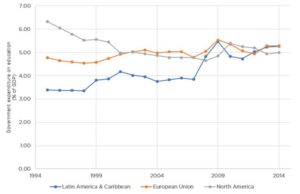For some years, social spending in Latin America and the Caribbean has been increasing. The data from Better Spending for Better Lives in 2018 show us that between 1995 and 2013 the average investment in education increased from 3.6% to 5.3% of gross domestic product (GDP) in Latin America and the Caribbean.

Investment in education is an important part of public spending, and certainly its increase is good news, but, do we need to spend more on education?
During the almost 25 years that I have dedicated myself to the education sector, I have had the opportunity to visit the Latin America’s countries and other regions of the world on multiple occasions. This has given me the opportunity to see first-hand the needs and effects of innovations and investments in educational communities. Undoubtedly, the increase in spending is necessary to achieve educational progress in Latin America and the Caribbean. Although there was a debate about whether more investment in education leads to better educational outcomes, the work of, among others, Kirabo Jackson, makes it clear that more investment does relate to better student learning outcomes.
Most countries in Latin America and the Caribbean have been betting on education, significantly increasing investment as a percentage of Gross Domestic Product, GDP. In these times of fiscal crisis in many of the countries of the region, now the most important and pressing challenge is to ensure that this increase has positive returns, especially in the quality and equity of the learning and skills acquired by our children, and young people during their educational trajectories.
Higher spending per student must be accompanied by transparency measures that reduce corruption, increase investment in teachers (the most important school factor) and introduce incentives for all system actors – principals, coordinators, teachers and students – to make their best effort to ensure that all our children and young people can acquire the necessary skills to reach their maximum potential and succeed in this changing world. Moving in this direction would allow our school systems to approach the learning levels of the most developed countries.
Investing in education throughout the life cycle is the goal, and the key to obtaining a better return on investment is early education. It allows children to develop skills and abilities from the first years of life and reduce gaps that broaden in early childhood. Instead of teaching a fixed body of knowledge, investing to “learn to learn” is essential. We know that many of the jobs of the future are unknown to us today and that our life expectancy is increasing, presenting opportunities (almost necessarily) of career, profession or trade changes, that little existed in the past. Finally, investing in the so-called 21st century skills – socio-emotional skills, digital skills and in the areas of science, mathematics, engineering and the arts – is increasingly necessary to achieve the citizens that we need in the 21st century.
Up to now, the debate on education in LAC has focused mainly on the quality of education and consequently on learning. With the unfavorable scenario of economic growth in the region and the need to improve the, still, low levels of learning, the region needs not only to invest more in education but, above all, to invest better to ensure that all children and young people acquire the skills necessary to reach their maximum potential.



Leave a Reply